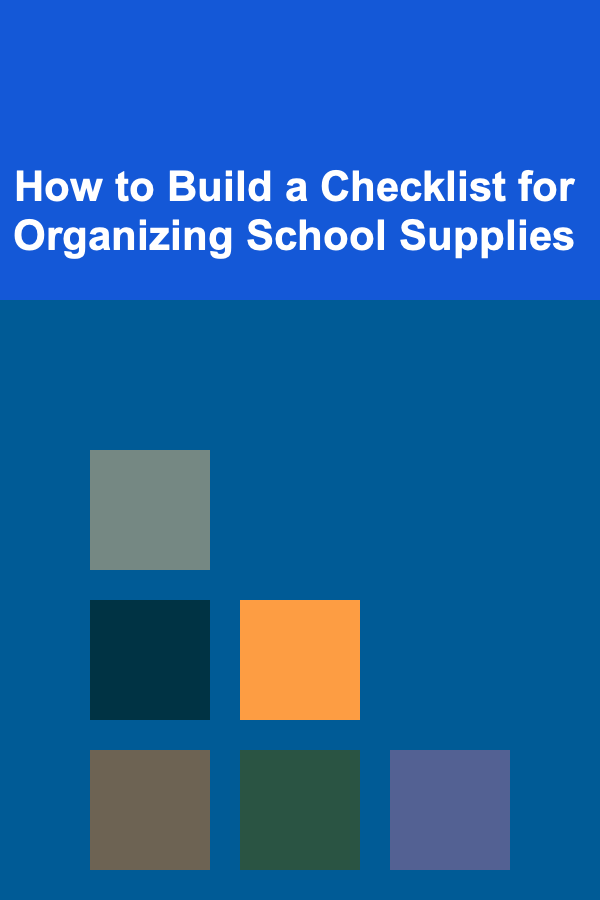
How to Build a Checklist for Organizing School Supplies
ebook include PDF & Audio bundle (Micro Guide)
$12.99$8.99
Limited Time Offer! Order within the next:

When it comes to preparing for a new school year, having a well-organized approach to school supplies can significantly reduce stress and increase productivity. Whether you're a student preparing for a new semester or a parent managing the back-to-school shopping for your children, creating a checklist is an effective way to ensure that everything is accounted for. This guide will provide a step-by-step approach to building a comprehensive checklist that covers all aspects of organizing school supplies efficiently and thoroughly.
Step 1: Assess the Specific Requirements
Before diving into buying supplies or organizing, it's crucial to understand the specific needs. Different grade levels, school types, and courses may have unique supply requirements. Reviewing the school's supply list or any specific instructions provided by teachers will guide your checklist's content. Here's what you should consider:
- Grade and Subject Requirements: Different subjects often require specific supplies. For example, math classes may require a calculator or protractor, while art classes will need sketchbooks, colored pencils, and other artistic tools.
- Teacher Requests: Teachers sometimes provide specific requests for supplies, such as a certain brand of pens, notebooks, or folders. Pay attention to these details to avoid purchasing unnecessary items.
- Personal Preferences: If the student has a preference for certain types of pens, pencils, or notebooks, take this into account when building the checklist.
By clarifying these aspects upfront, you can ensure that you aren't buying items that aren't needed while ensuring you don't miss any essential supplies.
Step 2: Categorize the Supplies
Creating categories for school supplies is an excellent way to break down the organization process and keep everything in order. A categorized checklist allows you to focus on one area at a time, preventing you from feeling overwhelmed by the list of items. Below are the main categories you should consider when building your checklist:
1. Writing Tools
Writing tools are some of the most commonly used school supplies. Ensuring you have the right types and quantities of each can be key to staying organized.
- Pencils (mechanical or traditional)
- Pens (blue, black, and red)
- Highlighters
- Erasers (both pencil and whiteboard)
- Markers
- Dry erase markers (for whiteboard use)
2. Paper and Notebooks
Paper and notebooks are fundamental for note-taking and assignments. Make sure you have a variety of paper types for different uses.
- Spiral notebooks (one per subject or as required)
- Loose-leaf paper (college-ruled or wide-ruled)
- Folders (one per subject)
- Graph paper (for math and science)
- Construction paper (for art classes)
3. Storage and Organization
Proper organization tools are essential to keeping school supplies neat and accessible throughout the school year.
- Binders (for organizing notes, assignments, and handouts)
- Pencil cases or pouches (for carrying pens, pencils, and smaller supplies)
- Folders or expanding files (for homework and projects)
- Book bags or backpacks
- Locker organizers (for students with lockers)
- Sticky notes or index cards (for flashcards, reminders, and study aids)
4. Art Supplies
Art supplies are necessary for any creative projects or art-based subjects. It's important to ensure that you have everything needed for art classes.
- Crayons, colored pencils, or markers
- Paints (acrylic or watercolor)
- Brushes (various sizes)
- Glue sticks or liquid glue
- Scissors (safety scissors for younger students)
- Ruler or measuring tape
- Construction paper
5. Technology and Miscellaneous Tools
In today's digital age, technology plays a big role in education. While not every student will need tech supplies, these tools are becoming more common in classrooms.
- Laptop or tablet (if required by the school)
- Headphones or earbuds (for online learning or video content)
- USB flash drive (for storing and transferring files)
- Calculator (scientific or graphing, as required for math and science classes)
6. Personal Hygiene and Miscellaneous Items
For younger students or elementary schools, ensuring the right hygiene items are available is just as important as academic supplies.
- Hand sanitizer
- Tissues
- Water bottle
- Lunchbox or bag
Step 3: Estimate Quantities
Once you've categorized your school supplies, the next step is to determine the correct quantity of each item. To do this, consider how frequently each item will be used, how long the school year lasts, and any specific requests from teachers.
For instance, you might need:
- Pencils: 10--12 pencils for the entire year (or more if the student tends to lose them quickly)
- Notebooks: One notebook per subject, with additional notebooks for subjects like writing or history.
- Pens: A set of 3--4 pens (of each color) to rotate between.
Don't forget that items like folders and binders can be reused year after year, so consider buying quality products that will last. If possible, buying a few extra supplies to have on hand can prevent last-minute trips to the store when supplies run low.
Step 4: Create the Checklist
With all the categories and quantities in mind, it's time to create your checklist. Below is an example of how to structure your checklist for easy reference:
Example School Supplies Checklist
Writing Tools
- [ ] Pencils (12 pack)
- [ ] Pens (black, blue, red - 3 of each)
- [ ] Highlighters (set of 4)
- [ ] Erasers (2 large)
- [ ] Markers (set of 12)
- [ ] Dry erase markers (pack of 4)
Paper and Notebooks
- [ ] Spiral notebooks (7, one per subject)
- [ ] Loose-leaf paper (200 sheets)
- [ ] Folders (7, one per subject)
- [ ] Graph paper (1 pack)
- [ ] Construction paper (1 pack)
Storage and Organization
- [ ] Binder (2, for organizing subjects)
- [ ] Pencil case (1)
- [ ] Expanding file folder (1)
- [ ] Backpack (1)
- [ ] Locker organizer (optional)
Art Supplies
- [ ] Crayons (1 box)
- [ ] Colored pencils (1 pack)
- [ ] Glue sticks (2)
- [ ] Scissors (1 pair)
- [ ] Ruler (1)
- [ ] Paint set (optional)
Technology and Miscellaneous Tools
- [ ] Laptop or tablet (if required)
- [ ] Headphones (1)
- [ ] USB flash drive (1)
- [ ] Calculator (1, scientific or graphing)
Personal Hygiene and Miscellaneous Items
- [ ] Hand sanitizer (1 bottle)
- [ ] Tissues (1 box)
- [ ] Water bottle (1)
- [ ] Lunchbox (1)
Step 5: Shop for Supplies
Now that your checklist is organized and clear, it's time to shop for supplies. Having a physical or digital list will help you stay focused on what you need and avoid impulse buys. Depending on your budget and preference, you can choose to shop online, visit physical stores, or a combination of both.
When shopping:
- Compare prices: Check multiple stores or online marketplaces to find the best deals.
- Look for multi-packs: Many items, like pens and pencils, can be bought in bulk, which may save you money in the long run.
- Invest in quality: Certain items, like backpacks, binders, and calculators, can last for years, so it's worth spending a little more on higher-quality products.
Step 6: Organize and Store Supplies
Once all supplies are purchased, the next step is organizing them effectively. An organized space will make it easier to locate and access everything needed throughout the school year.
- Use bins or storage containers: Store extra supplies in labeled bins, so they remain easy to find.
- Designate a workspace: Keep all school supplies in a specific area or desk, allowing for easy access and minimal clutter.
- Refill supplies regularly: Keep track of when supplies are running low and restock as necessary.
Step 7: Maintain and Update the Checklist
Throughout the school year, it's a good idea to keep your checklist updated. If additional supplies are required or if something breaks, take note and replenish items as necessary. This way, you'll always be prepared and won't have to deal with last-minute shopping before a big exam or project.
Conclusion
Building a comprehensive checklist for organizing school supplies can streamline your preparation for the school year and set you up for success. By assessing your needs, categorizing items, estimating quantities, and staying organized, you'll ensure that you have everything required to make the school year run smoothly. With proper planning and organization, you'll minimize stress and focus on what really matters---learning and growing.
Reading More From Our Other Websites
- [Personal Financial Planning 101] How to Financially Plan After Divorce: Key Considerations and Strategies
- [Organization Tip 101] How to Use Technology to Enhance Your Fitness Organization
- [Organization Tip 101] Eco-Friendly Furniture Stripping: Sustainable Solutions for Homeowners
- [Home Security 101] How to Secure Your Vacation Home While You're Away
- [Home Staging 101] How to Stage Your Home to Attract Millennial Buyers
- [Ziplining Tip 101] How to Overcome Fear of Heights Before Your First Zipline Ride
- [Biking 101] Downhill Bike vs. Mountain Bike: What's the Difference?
- [Organization Tip 101] Why Creating a Family Photo Storage System is Important
- [Biking 101] Bike Shorts vs. Cycling Tights: Which One Should You Choose?
- [Organization Tip 101] How to Train Employees on Office Supply Organization

Advanced Techniques in Data Analytics for Modern Data Analysts
Read More
How to Use Graphic Design Tools to Make Money
Read More
How to Use Web Scraping Tools to Make Money
Read MoreMastering Creative Direction: Essential Skills for Building Iconic Brands
Read More
How To Find Books That Explore Ethics and Morality
Read More
10 Tips for a Crochet Project Checklist: Beginners Edition
Read MoreOther Products

Advanced Techniques in Data Analytics for Modern Data Analysts
Read More
How to Use Graphic Design Tools to Make Money
Read More
How to Use Web Scraping Tools to Make Money
Read MoreMastering Creative Direction: Essential Skills for Building Iconic Brands
Read More
How To Find Books That Explore Ethics and Morality
Read More